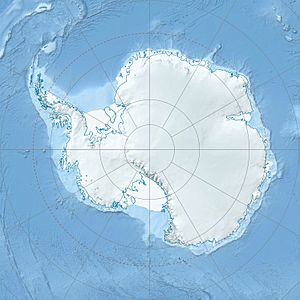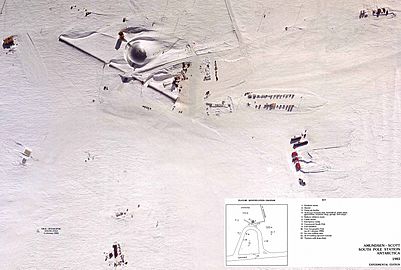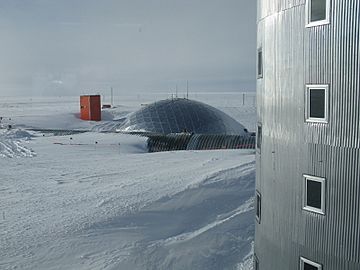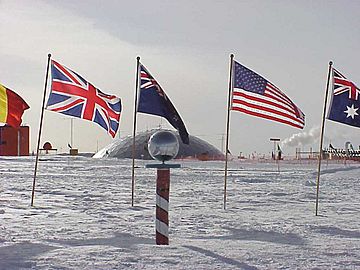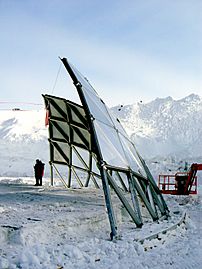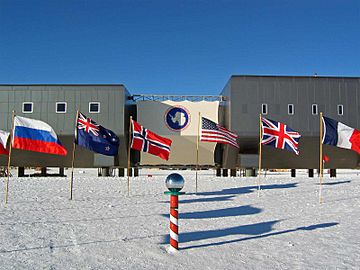Amundsen–Scott South Pole Station facts for kids
Quick facts for kids
Amundsen–Scott Station
|
||
|---|---|---|
|
Antarctic base
|
||
| Amundsen–Scott South Pole Station | ||

The Amundsen–Scott Station in November 2009. In the foreground is Destination Alpha, one of the two main entrances.
|
||
|
||

A map of Antarctica showing the location of the Amundsen–Scott South Pole Station (circled)
|
||
| Country | United States | |
| Location in |
Geographic South Pole, Antarctic Plateau | |
| Administered by | United States Antarctic Program by the National Science Foundation | |
| Established | November 1956 | |
| Named for | Roald Amundsen and Robert F. Scott | |
| Elevation | 9,301 ft (2,835 m) | |
| Population
(2017)
|
||
| • Summer | 150 | |
| • Winter | 49 | |
| Time zone | UTC+12 (NZST) | |
| • Summer (DST) | UTC+13 (NZDT) | |
| Type | All year-round | |
| Period | Annual | |
| Status | Operational | |
| Activities |
List
Glaciology
Geophysics Seismology Astrophysics Astronomy Biology |
|
| Facilities |
List
Jack F. Paulus Skiway
Accommodation Atmospheric Research Observatory Martin A. Pomerantz Observatory for astrophysics Computer systems for research and communication Collection of the longest continuous set of meteorological data from Antarctica Astronomy and astrophysics A small biomedical research facility Hydroponic Greenhouse Other areas of interest include glaciology, geophysics and seismology, ocean and climate systems, astrophysics, astronomy, and biology. |
|
| Website | ||
The Amundsen–Scott South Pole Station is a United States science station located at the very bottom of the Earth, the South Pole. It is the southernmost place where the United States has a presence. The station sits on a high, flat area in Antarctica called the Antarctic Plateau, about 9,301 feet (2,835 m) above sea level. The United States Antarctic Program (USAP) manages the station. It is named after two famous explorers, Norwegian Roald Amundsen and Briton Robert F. Scott. They both led teams that raced to be the first to reach the South Pole in the early 1900s.
The first Amundsen–Scott Station was built by the U.S. Navy Seabees in November 1956. This was part of a big science project called the International Geophysical Year (1957-1958). This project aimed to study Earth's polar regions and other things. Before 1956, there were no permanent buildings or many people in the middle of Antarctica. Most science stations were only near the coast. The Amundsen–Scott Station has been used continuously since it was built. It has been rebuilt and improved several times over the years.
At the South Pole, the Sun is visible all the time for six months. Then, it is completely dark for the next six months. There are about two days of twilight (partly light, partly dark) in between, called the equinoxes. During the six-month "day," the Sun slowly changes its position in the sky. It rises around September and is highest in December (summer for the South Pole). It sets around March. During the six-month polar night, temperatures can drop below −73 °C (−99 °F). Blizzards are also more common. When the weather is clear, the long darkness and dry air make the station a great place for astronomical observations.
The number of scientists and support staff at the station changes with the seasons. In the summer (October to February), there are usually around 150 people. In recent years, about 50 people stay during the winter.
Contents
Station Buildings Over Time
First Station (1957–1975)
The first South Pole station is now called "Old Pole." It was built by U.S. Navy Seabees. The first group of eight Seabees arrived on November 20, 1956. Most of the building materials were dropped from planes. The buildings were made from pre-made panels. These panels were four inches (10 cm) thick, with aluminum inside and plywood outside, filled with fiberglass. The buildings had skylights instead of windows. Tunnels made of burlap and chicken wire connected the buildings. The construction crew left on January 4, 1957.
The first group to stay through the winter included eight scientists and eight Navy support staff. The camp had an observatory, a weather tower, and a snow tunnel. This tunnel had spaces for tools to measure earthquakes and Earth's magnetic field. The lowest temperatures recorded were around −90 °F (−68 °C) to −99 °F (−73 °C). One person noted that "even at −60 °F (−51 °C) I had seen men spitting blood" because of the extreme cold.
On January 3, 1958, Sir Edmund Hillary's team from New Zealand reached the station by land. Sir Vivian Fuchs' British team followed soon after. The buildings of Old Pole were built on the surface. But snow builds up quickly around raised structures. By 1960, just three years after it was built, the station was already buried under 6 feet (1.8 m) of snow.
The original station was left in 1975. It became deeply buried, and the heavy snow caused the wooden roof to collapse. The station was taken down in December 2010.
Dome Station (1975–2010)
In 1975, the station moved to a new building: a large, round Buckminster Fuller geodesic dome. It was 160 feet (50 m) wide and 52 feet (16 m) high. It had steel archways, one of which was the main entrance. Inside the dome were smaller buildings for living, eating, recreation, and labs. These labs were used to study the atmosphere and for astronomy and astrophysics projects. The station also had a tall, box-shaped tower called Skylab, connected to the dome by a tunnel. Skylab held weather sensors and later a music room.
During the summers from 1970 to 1974, the Seabees building the dome lived in temporary huts. These huts were made of a wooden frame with a raised floor and canvas cover. Even with heaters, they were not warm enough for winter. Later, more temporary huts were added for summer staff. These huts formed a "summer camp."
While the dome was the main station, many changes happened. From the 1990s, science research at the South Pole became very important. The clear, dry air made it perfect for studying space. Experiments like the Python, Viper, and DASI telescopes were set up. The 390-inch (10 m) South Pole Telescope was also built. The AMANDA and IceCube experiments use the thick ice sheet to find tiny particles called neutrinos. A special observatory building, the Martin A. Pomerantz Observatory (MAPO), opened in 1995.
In 1988, a loud crack was heard in the dome. It turned out that the main support beams were broken from too much stress. The dome was taken apart in late 2009. Its parts are now stored in California, and its central top part is on display at a museum.
-
The main entrance to the former geodesic dome. The dome was slowly buried by snow and ice.
New Elevated Station (2008–Present)
In 1992, plans for a new station began. It would be a 7,400 m2 (80,000 sq ft) building with two floors, costing about US$150 million. Construction started in 1999, next to the old dome. The new station officially opened on January 12, 2008. Important people, including the head of the National Science Foundation, attended the ceremony. All the building materials for the new station were flown in from McMurdo Station by large LC-130 Hercules planes. Each plane carried about 26,000 pounds (12,000 kg) of cargo. The total weight of materials was 24,000,000 pounds (11,000,000 kg).
The new station has a special design. It can be made taller to prevent it from being buried by snow. About 8 inches (20 cm) of snow falls each year and never melts. The building has rounded corners and edges to help reduce snowdrifts. It faces into the wind with a sloped lower wall. This angled wall makes the wind blow faster under the building, which helps to clear away the snow. This design keeps the building from being quickly buried.
The building's supports are designed to handle the ground settling unevenly over time. If the building starts to sink unevenly, it can be lifted up. New sections can be added to the support columns, and then the building is jacked up to a higher level.
-
The station at night. The new station is on the far left, the power plant in the center. The green light in the sky is the aurora australis.
How the Station Works
During the summer, about 150 people live at the station. Most people leave by mid-February. A smaller group, usually around 39 people (in 2021), stays for the winter. These "winter-overs" are mostly support staff and a few scientists. They keep the station running through the long Antarctic night. The winter crew is completely isolated from mid-February to late October. Staying through the winter can be very challenging. The station is self-sufficient in winter, powered by three generators that run on jet fuel. A fun tradition for the winter-overs is watching all three "The Thing" movies after the last flight leaves for the winter.
Scientists at the station study many things. These include glaciology (ice), geophysics (Earth's physical processes), meteorology (weather), upper atmosphere physics, astronomy, astrophysics (space science), and biomedicine (health). Many winter scientists work on the IceCube Neutrino Observatory or on astronomy projects like the South Pole Telescope. The very cold, dry air and high altitude make the South Pole an excellent place for sensitive equipment to study space.
There is a small greenhouse at the station. It grows fresh vegetables and herbs like eggplant and jalapeños. These plants grow hydroponically, meaning they use only water and nutrients, no soil. The greenhouse is the only source of fresh produce during the winter.
Getting There
The station has a runway for planes that is 12,000 feet (3,658 m) long. From October to February, special ski-equipped Lockheed LC-130 Hercules planes fly several times a day. These planes bring supplies and people from McMurdo Station to the South Pole. These supply missions are part of an operation called Operation Deep Freeze.
There is also a snow road over the ice sheet from McMurdo, called the McMurdo-South Pole highway. It is 995 miles (1,601 km) long.
Staying Connected
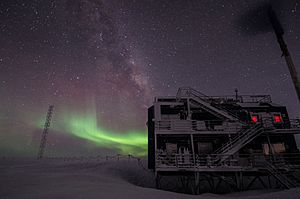
The station gets internet and phone service from several satellites. These include NASA's TDRS satellites, the DOD DSCS-3 satellite, and the commercial Iridium satellite constellation. Most of the data comes from the TDRS satellites, which can send data at 50 Mbit/s. When these main satellites are in range, the station's phone system can make calls. When they are out of range, the Iridium satellite system provides limited communication. This allows small emails (under 100 KB) to be sent and received at all times.
Amateur ham radio has also been used for communication. It helps with emergency messages and also for people to connect with others around the world as a hobby. Ham radio operators at the South Pole have used call signs like KC4 and AT.
Space Science at the Station
The South Pole is a unique place for studying space. Here are some of the telescopes and experiments:
Telescopes for Cosmic Microwave Background:
- Python Telescope (1992–1997): Used to study tiny temperature differences in the light left over from the Big Bang.
- Viper Telescope (1997–2000): Also studied temperature differences in the cosmic microwave background (CMB).
- DASI (1999–2000): Measured the temperature and power of the CMB.
- The QUaD (2004–2009): Used the DASI mount to make detailed observations of CMB polarization.
- BICEP1 (2006–2008) and BICEP2 (2010–2012): These instruments also looked at polarization in the CMB. BICEP3 was set up in 2015.
- South Pole Telescope (2007–present): Surveys the CMB to find distant groups of galaxies.
- The Keck Array (2010–present): Uses the DASI mount to continue studying CMB polarization.
Neutrino Experiments:
- AMANDA (1997–2009): An experiment to find tiny particles called neutrinos.
- IceCube (2010–present): A larger experiment that also detects neutrinos.
- Radio Ice Cherenkov Experiment (RICE) (1999–2012): An experiment to detect very high-energy neutrinos.
- Neutrino Array Radio Calibration (NARC) (2008–2012): An upgrade of the RICE experiment.
- Askaryan Radio Array (ARA) (2011–present): A newer experiment that follows RICE, still being built.
Climate
The Amundsen–Scott South Pole Station has an ice cap climate. This means it is always very cold, with snow and ice covering the ground. The warmest part of the year, summer, lasts from December to mid-February.
| Climate data for Amundsen–Scott South Pole Station | |||||||||||||
|---|---|---|---|---|---|---|---|---|---|---|---|---|---|
| Month | Jan | Feb | Mar | Apr | May | Jun | Jul | Aug | Sep | Oct | Nov | Dec | Year |
| Record high °C (°F) | −14.8 (5.4) |
−20.6 (−5.1) |
−26.7 (−16.1) |
−27.8 (−18.0) |
−25.1 (−13.2) |
−28.8 (−19.8) |
−33.9 (−29.0) |
−32.8 (−27.0) |
−29.3 (−20.7) |
−25.1 (−13.2) |
−18.9 (−2.0) |
−12.3 (9.9) |
−12.3 (9.9) |
| Mean maximum °C (°F) | −19.3 (−2.7) |
−26.7 (−16.1) |
−35.4 (−31.7) |
−39.9 (−39.8) |
−37.7 (−35.9) |
−41.1 (−42.0) |
−40.6 (−41.1) |
−42.5 (−44.5) |
−38.2 (−36.8) |
−37.2 (−35.0) |
−27.0 (−16.6) |
−20.5 (−4.9) |
−18.2 (−0.8) |
| Mean daily maximum °C (°F) | −26.0 (−14.8) |
−37.9 (−36.2) |
−49.6 (−57.3) |
−53.0 (−63.4) |
−53.6 (−64.5) |
−54.5 (−66.1) |
−55.2 (−67.4) |
−54.9 (−66.8) |
−54.4 (−65.9) |
−48.4 (−55.1) |
−36.2 (−33.2) |
−26.3 (−15.3) |
−45.8 (−50.4) |
| Daily mean °C (°F) | −28.4 (−19.1) |
−40.9 (−41.6) |
−53.7 (−64.7) |
−57.8 (−72.0) |
−58.0 (−72.4) |
−58.9 (−74.0) |
−59.8 (−75.6) |
−59.7 (−75.5) |
−59.1 (−74.4) |
−51.6 (−60.9) |
−38.2 (−36.8) |
−28.0 (−18.4) |
−49.5 (−57.1) |
| Mean daily minimum °C (°F) | −29.6 (−21.3) |
−43.1 (−45.6) |
−56.8 (−70.2) |
−60.9 (−77.6) |
−61.5 (−78.7) |
−62.8 (−81.0) |
−63.4 (−82.1) |
−63.2 (−81.8) |
−61.7 (−79.1) |
−54.3 (−65.7) |
−40.1 (−40.2) |
−29.1 (−20.4) |
−52.2 (−62.0) |
| Mean minimum °C (°F) | −34.9 (−30.8) |
−51.4 (−60.5) |
−66.2 (−87.2) |
−69.6 (−93.3) |
−70.2 (−94.4) |
−72.8 (−99.0) |
−72.3 (−98.1) |
−72.6 (−98.7) |
−73.6 (−100.5) |
−66.8 (−88.2) |
−48.8 (−55.8) |
−35.2 (−31.4) |
−75.3 (−103.5) |
| Record low °C (°F) | −41.1 (−42.0) |
−58.9 (−74.0) |
−71.1 (−96.0) |
−75.0 (−103.0) |
−78.3 (−108.9) |
−82.8 (−117.0) |
−80.6 (−113.1) |
−79.3 (−110.7) |
−79.4 (−110.9) |
−72.0 (−97.6) |
−55.0 (−67.0) |
−41.1 (−42.0) |
−82.8 (−117.0) |
| Average precipitation mm (inches) | 0.3 (0.01) |
0.6 (0.02) |
0.2 (0.01) |
0.1 (0.00) |
0.2 (0.01) |
0.1 (0.00) |
0.0 (0.0) |
0.0 (0.0) |
0.1 (0.00) |
0.1 (0.00) |
0.1 (0.00) |
0.3 (0.01) |
2.3 (0.09) |
| Average snowfall cm (inches) | 0.3 (0.1) |
0.5 (0.2) |
— | — | 0.3 (0.1) |
— | trace | — | — | — | — | 0.3 (0.1) |
1.3 (0.5) |
| Average precipitation days (≥ 0.1 mm) | 0.2 | 0.3 | 0.2 | 0.0 | 0.2 | 0.1 | 0.0 | 0.0 | 0.1 | 0.1 | 0.1 | 0.3 | 1.6 |
| Average snowy days | 22.0 | 19.6 | 13.6 | 11.4 | 17.2 | 17.3 | 18.2 | 17.5 | 11.7 | 16.7 | 16.9 | 20.6 | 203.0 |
| Mean monthly sunshine hours | 406.1 | 497.2 | 195.3 | 0.0 | 0.0 | 0.0 | 0.0 | 0.0 | 34.1 | 390.6 | 558.0 | 616.9 | 2,698.2 |
| Mean daily sunshine hours | 13.1 | 17.6 | 6.3 | 0.0 | 0.0 | 0.0 | 0.0 | 0.0 | 1.1 | 12.6 | 18.6 | 19.9 | 7.4 |
Time Zone
At the South Pole, the Sun only rises and sets once a year. Because of how light bends in the atmosphere, these events don't happen exactly on the September equinox and March equinox. The Sun stays above the horizon for four extra days at each equinox. There is no normal "day" or "night" like we experience. The station uses New Zealand time (UTC+12, or UTC+13 during daylight saving). This is because all flights to McMurdo Station leave from Christchurch, New Zealand. So, all official travel from the South Pole goes through New Zealand.
See also
 In Spanish: Base Amundsen-Scott para niños
In Spanish: Base Amundsen-Scott para niños
- Concordia Station
- Kunlun Station
- List of Antarctic field camps
- List of Antarctic research stations
- Paul Siple
- Polheim, Amundsen's name for the first South Pole camp.
- Scott Base
- Vostok Station



